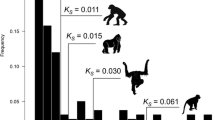Abstract
Although gene duplication has generally been viewed as a necessary source of material for the origin of evolutionary novelties, the rates of origin, loss, and preservation of gene duplicates are not well understood. Applying steady-state demographic techniques to the age distributions of duplicate genes censused in seven completely sequenced genomes, we estimate the average rate of duplication of a eukaryotic gene to be on the order of 0.01/gene/million years, which is of the same order of magnitude as the mutation rate per nucleotide site. However, the average half-life of duplicate genes is relatively small, on the order of 4.0 million years. Significant interspecific variation in these rates appears to be responsible for differences in species-specific genome sizes that arise as a consequence of a quasi-equilibrium birth-death process. Most duplicated genes experience a brief period of relaxed selection early in their history and a minority exhibit the signature of directional selection, but those that survive more than a few million years eventually experience strong purifying selection. Thus, although most theoretical work on the gene-duplication process has focused on issues related to adaptive evolution, the origin of a new function appears to be a very rare fate for a duplicate gene. A more significant role of the duplication process may be the generation of microchromosomal rearrangements through reciprocal silencing of alternative copies, which can lead to the passive origin of post-zygotic reproductive barriers in descendant lineages of incipient species.
Similar content being viewed by others
References
Altschul, S. F., T. L. Madden, A. A. Schaffer, J. Zhang, Z. Zhang, W. Miller, and D. J. Lipman. 1997. Gapped BLAST and PSIBLAST: a new generation of protein database search programs. Nucleic Acids Res. 25: 3389-3402.
Bevan, M., K. Mayer, O. White, J. A. Eisen, D. Preuss, T. Bureau, S.L. Salzberg, H. W. Mewes. 2001. Sequence and analysis of the Arabidopsis genome. Curr. Opin. Plant Biol. 4: 105-110.
Conery, J. S., and M. Lynch. 2001. Nucleotide substitutions and the evolution of duplicate genes. Pacific Symp. Biocomput. 6: 167-178.
Cormen, T. H., C. E. Leiserson, and R. L. Rivest. 1990. Introduction to Algorithms. McGraw-Hill.
Grant, D., P. Cregan, and R. C. Shoemaker. 2000. Genome organization in dicots: genome duplication in Arabidopsis and synteny between soybean and Arabidopsis. Proc. Natl. Sci. USA 97: 4168-4173.
Gu, Z., A. Cavalcanti, F.-C. Chen, P. Bouman, and W.-H. Li. 2002. Extent of gene duplication in the genomes of Drosophila, nematode, and yeast. Mol. Biol. Evol. 19: 256-262.
Li, W.-H. 1999. Molecular Evolution. Sinauer Assocs., Sunderland, MA.
Lynch, M. 1997. Mutation accumulation in nuclear, organelle, and prokaryotic transfer RNA genes. Mol. Biol. Evol. 114: 914-925.
Lynch, M. 2003. Gene duplication and evolution. In A. Moya (ed.), Evolution: From Molecules to Ecosystems. Oxford University Press. (in press).
Lynch, M., and J. Conery. 2000. The evolutionary fate and consequences of duplicate genes. Science 290: 1151-1154.
Lynch, M., and A. Force. 2000. The origin of interspecific genomic incompatibility via gene duplication. Amer. Natur. 156: 590-605.
Lynch, M., M. O'Hely, B. Walsh, and A. Force. 2001. The probability of fixation of a newly arisen gene duplicate. Genetics 159: 1789-1804.
Ohno, S. 1970. Evolution by Gene Duplication. Springer-Verlag, Berlin.
Shapira, S. K., and V. G. Finnerty. 1986. The use of genetic complementation in the study of eukaryotic macromolecular evolution: rate of spontaneous gene duplication at two loci of Drosophila melanogaster. Mol. Biol. Evol. 23: 159-167.
Shioura, A., A. Tamura, and T. Uno. 1997. An optimal algorithm for scanning all spanning trees of undirected graphs. SIAM J. Comput. 26: 678-692.
Sokal, R. R., and F. J. Rohlf. 1995. Biometry. 3rd Ed. Freeman, Yew York.
Yang, Z. 1997. PAML: a program package for phylogenetic analysis by maximum likelihood. Comput. Appl. Biosci. 13: 555-556.
Author information
Authors and Affiliations
Rights and permissions
About this article
Cite this article
Lynch, M., Conery, J.S. The evolutionary demography of duplicate genes. J Struct Func Genom 3, 35–44 (2003). https://doi.org/10.1023/A:1022696612931
Issue Date:
DOI: https://doi.org/10.1023/A:1022696612931




